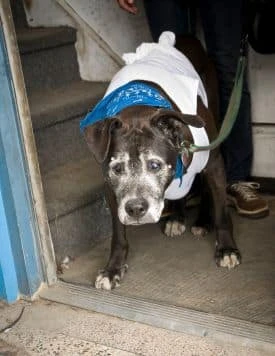Cataracts in Dogs, Symptoms,Treatment, Surgery Side Effects
Cataracts in Dogs

Cataracts in dogs is a very upsetting condition that can cause blindness…
Conseqently, on this page we have provided a complete guide to the causes, types, symptoms treatment including a quick guide to cataract surgery for dogs, it’s side effects and the recovery time…
So let’s get started…
Cataracts in Dogs
Signs and Symptoms…
- Cataracts in dogs is a very upsetting and debilitating eye disease that can attack all breeds. The disease is often seen in older dogs and can develop over a period of weeks, months and even years.
- The signs and symptoms of the disease include a milky cloud or white covering that appears on the surface of the eye. This cloudy substance stops your dog from being able to see light. Over time the cloudy substance will cover the whole eye causing complete blindness.
- Older dogs that develop the disease will nearly always develop it in both eyes at the same time.
Cataracts in Dogs
The Stages
Cataracts in dogs normally appears in the following stages…
- Incipient Cataracts – This is the start of the disease – your dog will still be able to to see as the disease is in it’s early stages.
- Immature Cataracts – This is the stage when the disease will cause blurred vision as the cloudy covering is starting to cover more of the eye.
- Mature Cataracts – This is when your dog’s eye is completely covered and your dog has lost complete vision.
Causes…
Although all dogs are susceptible to the disease, the following breeds seem more prone to developing it including the…
- Springer Spaniel
- Cocker Spaniel
- Afghan
- Old English Sheepdog
- West Highland Terrier
- Poodle
- Labrador
- Husky
- German Shepherd
- Golden Retriever
- Schnauzer
- The disease can occur from birth too when the developing puppy has not been given the proper nutrients.
- Diabetes can cause the disease – due to the high levels of glucose occurring in the aye ball fluid this will then cause the eye lens to absorb more water to try and dilute the excess sugar – this excess water can cause the eye to cloud over.
- Cataracts in dogs can also occur after an injury or accident to the eye – this will then cause the disease to only affect one eye as opposed to both.
- The disease can also occur in very young puppies who have been orphaned and then given artificial milk.
- A lack of amino acids in young puppies can also cause the disease.
- Free radicals can also cause the disease as they cause oxidizing in your dogs body – which then cause the eye to be damaged.
Treatment and Prevention…
- A good diet can be very successful in helping to protect your dog’s eyes including…
- Kale
- Carrots
- Green vegetables
- Vegetables rich in antioxidants help to fight against the free radicals mentioned earlier.
- Bilberry and vitamin E given in 50 mgs has been shown to stop the cloudy build up by as much as 97% in people and has been offered to dogs too.
- Beta-Carotene is also great for your dogs eyes as it is easily converted to vitamin A which is great for a dog’s overall eye health care.
- A herb that has been excellent helping to clear the cataract and comes in drops is cineraria.
Surgery, Side effects and Cost…
- Surgery can be offered as it will remove the cataracts. Surgery used to be offered as a last resort when vision had been completely lost. However, things have now changed and vets now like to perform surgery as early as possible. Surgery involves your dog’s infected or diseased eye lens being completely removed and then your vet replacing the lens with an artificial lens.
- Side effects of cataracts surgery in dogs is increased when the disease is more advance. The main reason for this is that if the disease has really taken hold then the eye lens may have become calcified which will make surgery more complicated and increase the side effects, risk and recovery time.
- The cost of cataracts surgery is allot and can vary from $1500 up to $3000 per eye and will involve your dog spending two days at the vet’s. Pet insurance is very important but it depends on your policy.
Go from cataracts in dogs back to free vet advice or back to dog obedience training home-page





